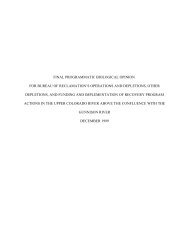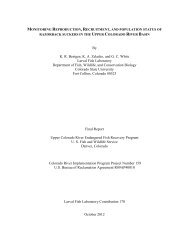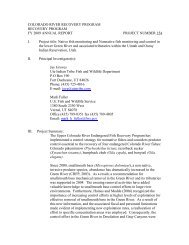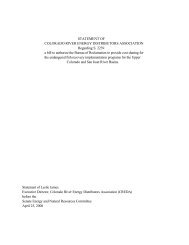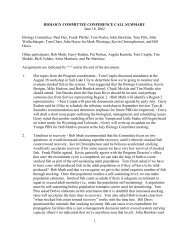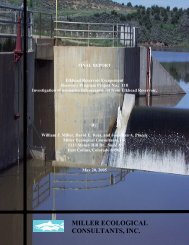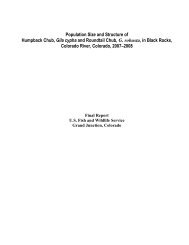riprap - Upper Colorado River Endangered Fish Recovery Program
riprap - Upper Colorado River Endangered Fish Recovery Program
riprap - Upper Colorado River Endangered Fish Recovery Program
You also want an ePaper? Increase the reach of your titles
YUMPU automatically turns print PDFs into web optimized ePapers that Google loves.
GENERAL RECOVERY PROGRAM SUPPORT ACTION PLAN Gen Table Page 3ACTIVITY WHO STATUSFY 1210/11-9/12FY 1310/12-9/13FY 1410/13-9/14FY 1510/14-9/15FY 1610/15-9/16OUTYEARSAssessment of significant accomplishments (!) and shortcomings (X),(Focused on February 1, 2011 - January 31, 2012)III.A.Reduce negative interactions between nonnative and endangered fishes.Basin-wide nonnative fish strategy (BW Strategy) draft submitted to BC andMC August 29 recommends focusing on prevention, eradication and swiftcontrol of problematic species. NNFSC met November 28, 2011 in GJ, COto review and discuss edits to BW Strategy. Agreed to have separatesection for PR/I&E drafted by I&E Committee, to incorporateresults/recommendation from final reports for Projects 161 (SMB Synthesis)and C-18/19 (otolith microchemistry), and pre- and post-reclamation(rotenone) guidance for PR, O&M, and replacement sport fisheries for UCRBreservoirs containing invasive piscivores (i.e. northern pike, smallmouthbass, walleye).III.A.1.Where not already generally known, identify negative impacts (e.g., predation, competition,hybridization) of problem species.III.A.1.a.Determine role of nonnative fishes as potential competitors with bonytails and determine size-specificvulnerability of bonytails to nonnative fish predators.UDWR CompleteIII.A.1.b. Assess impact of northern pike predation on <strong>Colorado</strong> pikeminnow in the Green <strong>River</strong>. UDWR CompleteAdler and Crowl 1995, Bissonette and Crowl 1995, Lentsch et al. 1996a.Crowl and Lentsch 1996.III.A.1.c.>* III.A.1.c.(1)III.A.1.d.III.A.2.III.A.2.a.III.A.2.b.Re-evaluate levels of hybridization with white sucker and assess effects on razorback suckerpopulations. (<strong>Program</strong> will monitor for evidence of hybridization as razorbacks increase in thesystem.)If necessary, implement actions to minimize hybridization between white sucker and razorbacksucker.Develop protocol for actions to be taken when a new nonnative species invasion or expansion isdetected. (YS E-1)Identify and implement viable active control measures.Identify options (including selective removal) to reduce negative impacts of problem species andassess regulations and options (including harvest) to reduce negative impacts on native fishes fromnonnative sportfish.Review options and develop agreement with appropriate States on strategies and locations forimplementing control options. Develop Nonnative <strong>Fish</strong> Management Policy.FWS/UDWR/CSUFWS/UDWR/CSUPDPDFWS/STATESOngoing X X X X X XPendingPendingCompleteCompleteHawkins and Nesler 1991; Lentsch et al. 1996b; Tyus and Saunders 1996.<strong>Upper</strong> <strong>Colorado</strong> <strong>River</strong> <strong>Endangered</strong> <strong>Fish</strong> <strong>Recovery</strong> <strong>Program</strong> 2004.CRFP-Grand Junction working with geneticists to determine incidence ofsucker hybridization in larval samples collected from <strong>Colorado</strong> and Gunnisonrivers. <strong>Program</strong> still needs to establish process to track percentages ofhybrid suckers using standardized protocol for identification of hybridizationat fish ladders and in monitoring reaches.See above.See III.B.6 below.>* III.A.2.c.Evaluate the effectiveness (e.g., nonnative and native fish response) and develop and implement anintegrated, viable active control program.PD/FWS/STATESOngoing X X X X X X! At the December 2011 Nonnative <strong>Fish</strong> Workshop, PI's, managers, andothers discussed preliminary results from the 2011 field studies andsuggested revIsions to the 2012 Work Plan. Revisions respond to the needto expand efforts to increase removal / disruption further into the SMBspawning period (e.g., sampling schedules being extended to exploitsmallmouth bass in post-peak flows on the Yampa). Additional removal willfocus on northern pike in <strong>Upper</strong> <strong>Colorado</strong> <strong>River</strong> near Rifle Creek confluenceand on SMB below Kenney Reservoir in <strong>Colorado</strong>. That said, we are learningthat the effectiveness of mechanical removal is somewhat limited,underscoring the need to take an integrated approach (i.e., BasinwideNonnative <strong>Fish</strong> Management Strategy) to achieve our managementobjectives.III.A.2.c.(1)Project-level synthesis: synthesize data on each species/river nonnative fish control effort andconcomitant native fish response (e.g., smallmouth bass in the Yampa <strong>River</strong> and native fishresponse in the Yampa <strong>River</strong>) (completed by PI’s and identified as a task in individual scopes ofwork). (YS G-3)PI's Ongoing X XFocus has shifted to species-level (programmatic) synthesis for nonnativefish management actions. The Nonnative <strong>Fish</strong> Subcommitteerecommended that syntheses be completed for: 1) Yampa <strong>River</strong> native fishresponse; 2) Green <strong>River</strong> native fish response; and 3) Lodore/WhirlpoolCanyon; however additional funding needed to complete these synthesisreports may not be available. Ongoing analysis of nonnative fish early lifehistory (otolith examination) as affected by environmental conditions needsto be finalized.Last modified: 6/11/2012 9:43:00 AM



